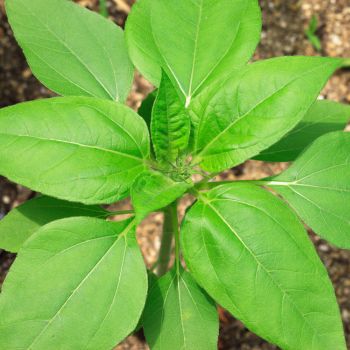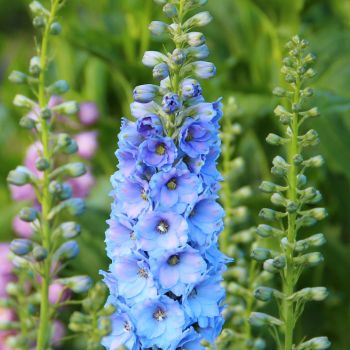Few things will transform your backyard, porch, or patio like live flowers. And while you can just head down to the florist and purchase some, it’s far more rewarding (and affordable) to grow your own flowers from seed.
But beginners rarely know where to start, and questions usually outnumber answers.
That’s OK! There’s certainly a lot you’ll need to learn as you begin growing your own flowers, but the important thing is to get started!
However, you’ll likely have more success if you start with some of the easiest flowers to grow. We’ll try to help below, by sharing some of the best flower seeds for beginners and explaining some of the traits they all share.
What Makes Some Flower Seeds Ideal for Beginners?
While there are a few exceptions, most of the best flowers for beginners share a few key traits. These generally include:
- The seeds are easy to handle. Some seeds are so small that they’re difficult to grip or pick up. The tiniest seeds may even blow away if a gust of wind occurs unexpectedly. Seeds of such size may need to be combined with fine sand or soil to facilitate the sowing process, which simply represents an additional step that novice gardeners may want to avoid.
- The seeds don’t require special germinating techniques. The seeds of some plants must be soaked or stratified to germinate. Soaking isn’t especially difficult, but it is another step that fledgling gardeners may wish to avoid. By contrast, the stratification process – which involves exposing the seeds to a specific temperature fluctuation to break their dormancy – can even be tricky for experienced gardeners.
- The flowers are usually easy to grow. Generally speaking, beginners will be best served by selecting flowers that grow easily and don’t require super-precise growing conditions. Gardenias, for example, are notoriously finicky flowers that can die if not provided with nearly perfect growing conditions. Instead, opt for flowers (such as the ones listed below), which are often tolerant of gardening mistakes.
- The plants aren’t susceptible to many pests or pathogens. Most flowering plants are vulnerable to a few pests and pathogens, but beginners are wise to avoid plants that are especially susceptible to bugs, moulds, and bacteria.
While some of the flowers recommended below fall short of one or two of these criteria, the majority of them check off most of these boxes.
Nine of the Best Flower Seeds for Beginners
While beginner gardeners are often attracted to some of the most spectacular flowers available, many of these (looking at you, orchids!) are simply too challenging for the average novice. But don’t worry – there are plenty of excellent flowers for beginners, including the nine discussed below.
1. Sunflower
That’s right – one of the most popular flower species in the world is also one of the easiest to grow from seed. Sunflower seeds have a lot going for them, as they are both large enough to handle easily and don’t require stratification or soaking.
Do be sure to select a location with plenty of sun exposure, as these are obviously sun-loving flowers (young sunflowers even “track” the sun’s progress across the sky – a phenomenon called heliotropism). You may also need to provide these tall flowers with some extra support in the form of stakes, but that’s not a huge problem.
There’s one other great reason to grow sunflowers: They come in an assortment of varieties, ranging from pollen-free varieties that are great for allergy suffers, to small, pom-pom like varieties that offer a different aesthetic. You can also select sunflowers of different colours, ranging from the familiar yellow varieties to burgundy, as well as multi-coloured options, including mauve and lemon and peach, mauve, and lilac.
.jpg)
2. Zinnia
Talk about colour – zinnias are available in just about every colour of the rainbow, from white to purple to orange. And like sunflowers, they’re generally quite easy for beginners to grow. In fact, they’re often recommended for children who’re interested in gardening. These sun-loving annuals generally grow between 70 and 100 cm tall, depending on the variety, and they work well in beds or border areas of your garden.
Zinnia seeds are large enough to handle easily, and they can be sown directly in your garden soil. You can also start them in small pots or trays, but you should use soil pellets or Jiffy Pots to minimize root damage when transplanting them. Zinnias are warm-weather flowers that are sensitive to low temperatures, so keep indoor-grown plants inside if late frosts are a possibility. Many of the varieties make excellent cut flowers, and they tend to attract an array of bees and other insects.
Zinnias can be susceptible to aphids and whiteflies, but a variety of cultural control methods – such as simply spraying the plants with a garden hose – can help keep these problems to manageable levels.
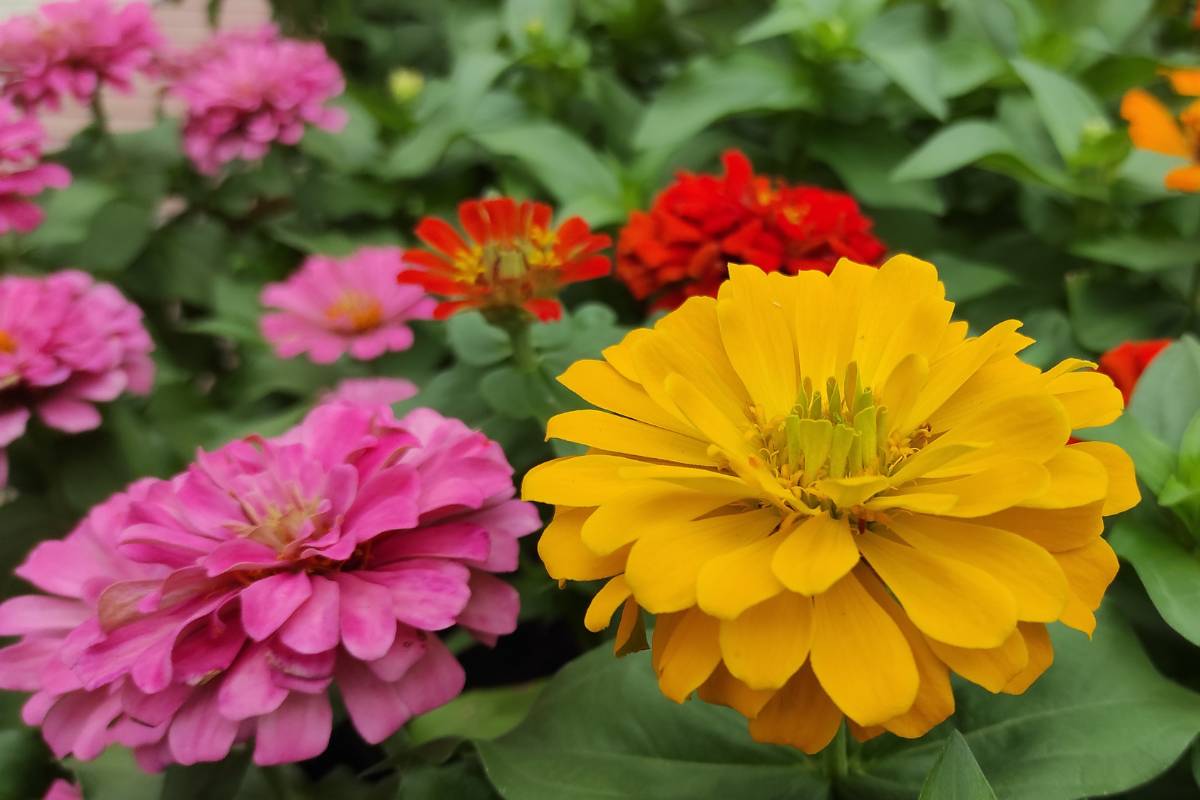
3. Cosmos
Cosmos is another great beginner flower that is available in myriad colours, but it also comes in several different shapes! From classically shaped varieties to eye-catching, cup-shaped varieties to anemone-centred options, there’s something for everyone.
Cosmos seeds are fairly large, so handling them isn’t a problem. They’re also ready to plant as is; they don’t need stratification or soaking. You can even scatter the seed over freshly prepared soil rather than sowing them individually (though you certainly can sow them individually if you wish).
But the seeds aren’t the only reason beginners often succeed with these flowers – they’re also quite hardy. Most varieties are drought tolerant, and they’ll often thrive in areas where other flowers won’t. Many varieties will also readily self-seed, meaning that you’ll enjoy new flowers for years to come. But that also means you should select a planting location in which you won’t mind new plants popping up.
Cosmos is also a fantastic cut flower, but you’ll want to clip them and bring them inside before they’re pollinated. Once pollinated, they begin shedding petals fairly quickly.
.jpg)
4. Nasturtium
Nasturtiums also come in a few different colours (multi-colour variety packs are quite popular), but they have a lot of other things going for them. In addition to being easy to grow, the plant’s leaves are unusually shaped, and often appear nearly circular. This means they can provide another “texture” and additional visual interest to your garden.
Nasturtiums are quite easy to grow; in fact, they self-seed so readily that care is often necessary to prevent them from spreading. If you don’t want additional nasturtiums popping up in your garden, be sure to “deadhead” them (remove the flowers before they can drop seeds). This has the additional benefit of encouraging additional flower production.
The seeds don’t require soaking or stratification, though some people claim to have better results after soaking the seeds for about 12 to 24 hours. Sow the seeds individually, about 15 cm deep and 30 to 45 cm away from each other.
In addition to being excellent garden flowers for beginners, nasturtium leaves and petals are edible and make great additions to salads – some people even use them medicinally. The seeds can also be ground and used as a pepper substitute.
.jpg)
5. Alyssum
Do you like tiny flowers? Alyssum may be the perfect choice! Available in white, yellow, and violet varieties, these four-petaled blossoms only measure a bit more than half a centimetre across! In fact, the entire plant is fairly small, with most varieties only reaching about 12 cm in height (and the ’Tiny Tim’ variety only reaches about 8 cm in height).
It is important to note that the name “alyssum” is applied to at least two different species. White and lavender varieties are known to botanists as Lobularia maritima, but ‘Mountain Gold’ alyssums are actually known as Aurinia saxatilis. Nevertheless, both species require similar growing conditions, so gardeners should feel free to choose either species.
Like the plant’s flowers, the seeds of alyssum are quite small, so care is necessary when handling them. But the seeds are otherwise undemanding. They don’t require soaking or stratification, and they can even be scattered, rather than having to be sown individually.
Best of all, pests and pathogens rarely cause problems for alyssum. Snails, slugs, and downy mildew are the only common problems, and these are often easy to address with cultural practices (such as removing snails and slugs when found, and watering plants at ground level).
.jpg)
6. Aster
Some of the best cut-flower specimens available, asters are easy to grow, great for beginners, and available in several different shapes and colours. Asters are also quite forgiving. In fact, some are even tolerant of difficult growing conditions, such as ‘Benary's ‘Princess Blue’ variety, which will grow in damp soil. Meanwhile, others, such as the variety ‘Powderpuff’, are wilt resistant.
Aster seeds are easy to handle, and they require neither soaking nor stratification. They do, however, grow best when started indoors in trays – you can move them outdoors once they’re established. Start them in Jiffy Pots or soil starter pellets for the best results.
Be sure to keep them indoors until the last chance of frost has passed (though mature plants will tolerate light frosts). Once transplanted, keep your eye on their development, as they may require stakes for support. Asters aren’t plagued by many pests, though aphids, slugs, and snails do occasionally cause problems.
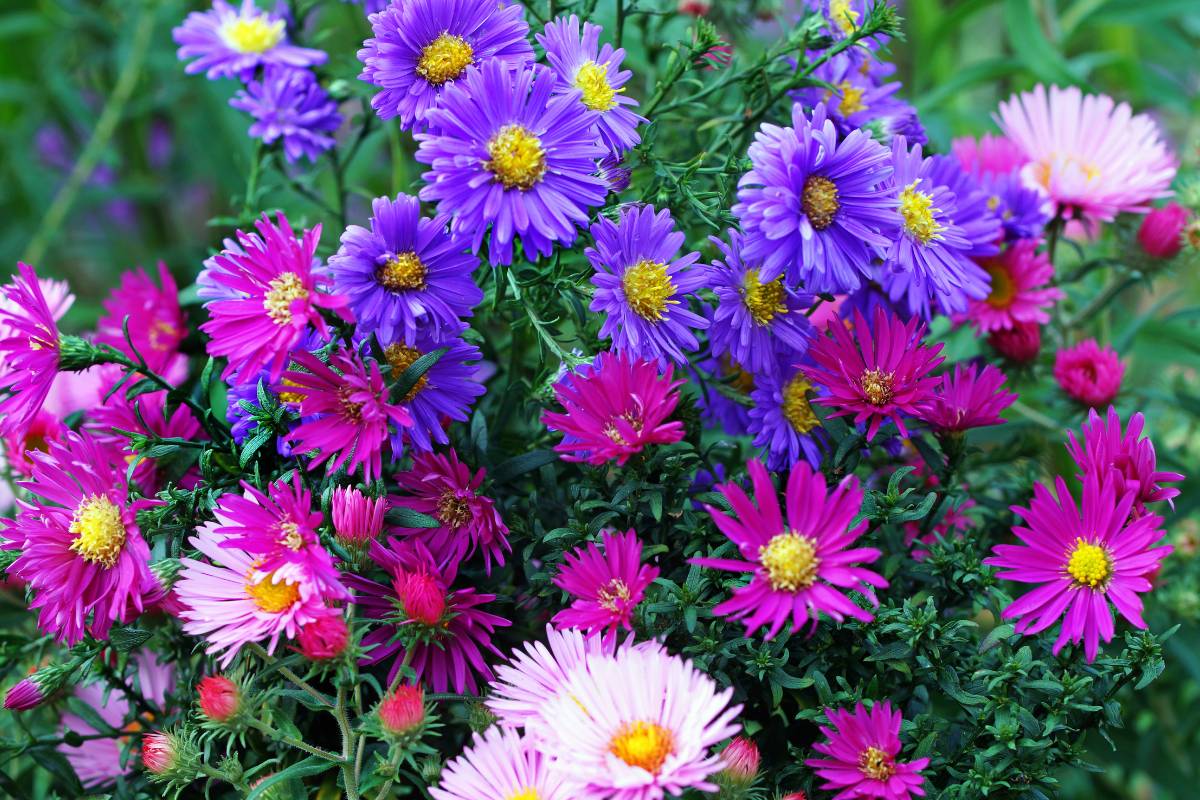
7. Calendula
Want some flowers you can use on the dinner table? The leaves and petals of calendulas are edible and used in a variety of culinary contexts. Some use them as a garnish, while others use them as a seasoning. They’re even used medicinally and as a cheese-colouring agent.
Generally reaching about 50 cm in height, these attractive flowers can be grown year-round in many areas. And unlike many other flowers, these will grow in partially shaded areas.
You can start calendula seeds in trays if you like, but they can also be sown directly in your garden soil (in fact, they self-seed very readily). The unusually shaped seeds are large enough to handle, and they can be sown without the need for soaking or stratification.
Like many other popular garden flowers, calendulas are available in several colour forms. Most are orange (though some orange varieties are especially vibrant), but you can also obtain yellow, peach, or coffee-and-russet-coloured varieties.
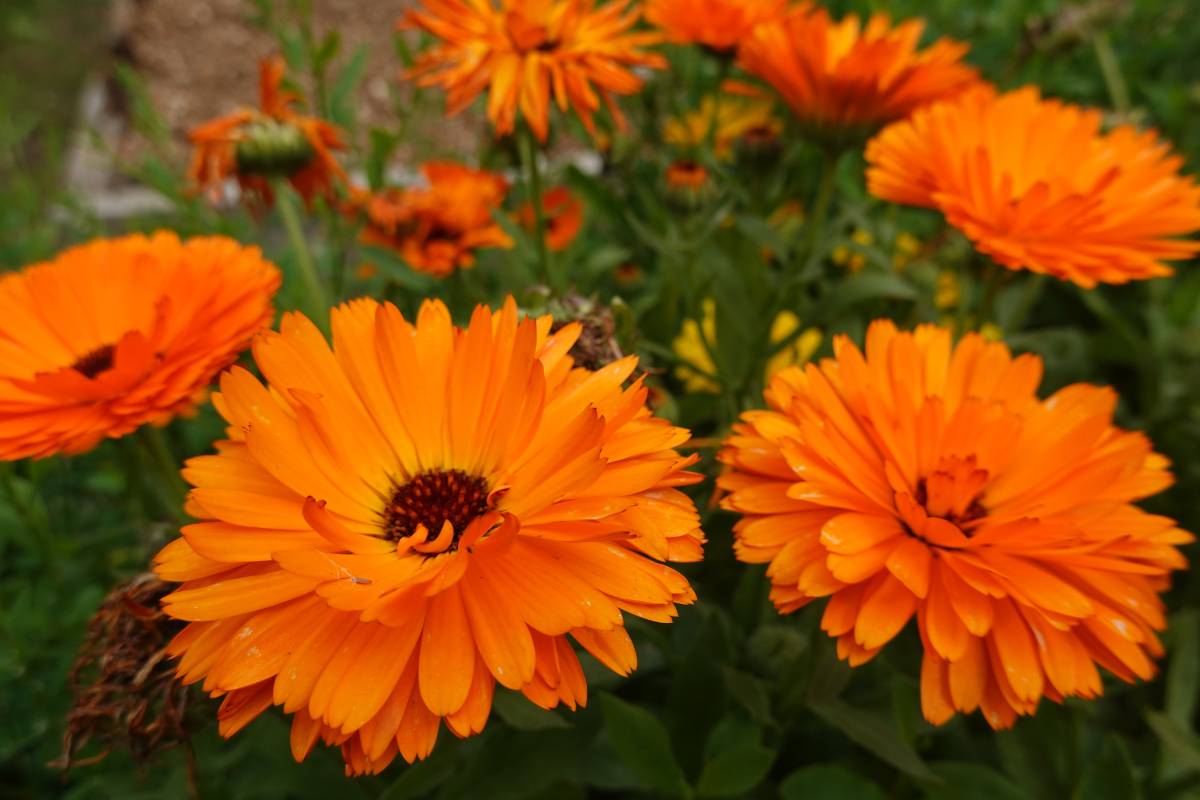
8. Marigold
Lots of flowers are grown, in part, for their ability to attract beneficial wildlife – especially bees, butterflies, and other pollinators. But others, such as marigolds, are valued for their ability to repel some types of harmful wildlife, namely rabbits. As it turns out, rabbits don’t like the way these pretty flowers smell.
But that’s not the only thing marigolds have going for them. They’re also very easy flowers for beginner gardeners to grow. Marigold seeds can be sown without stratifying or soaking them, and you don’t even have to sow them individually – you can simply scatter them on freshly prepared soil and cover them back up.
Note that there are three different marigold species available: African, French, and signet. African marigolds (which are originally native to Central and South America) are the tallest variety and capable of tolerating rather dry growing conditions. French marigolds are smaller and bushier, and they’re better able to tolerate damp conditions. Signet marigolds combine features of both – they’re relatively short, but they thrive in hot, dry climates.
Most marigolds will grow well in containers, and they’re available in an array of colours. Be sure to check out the ‘Mr. Majestic’ varieties, which produce gorgeous, bi-coloured flowers.
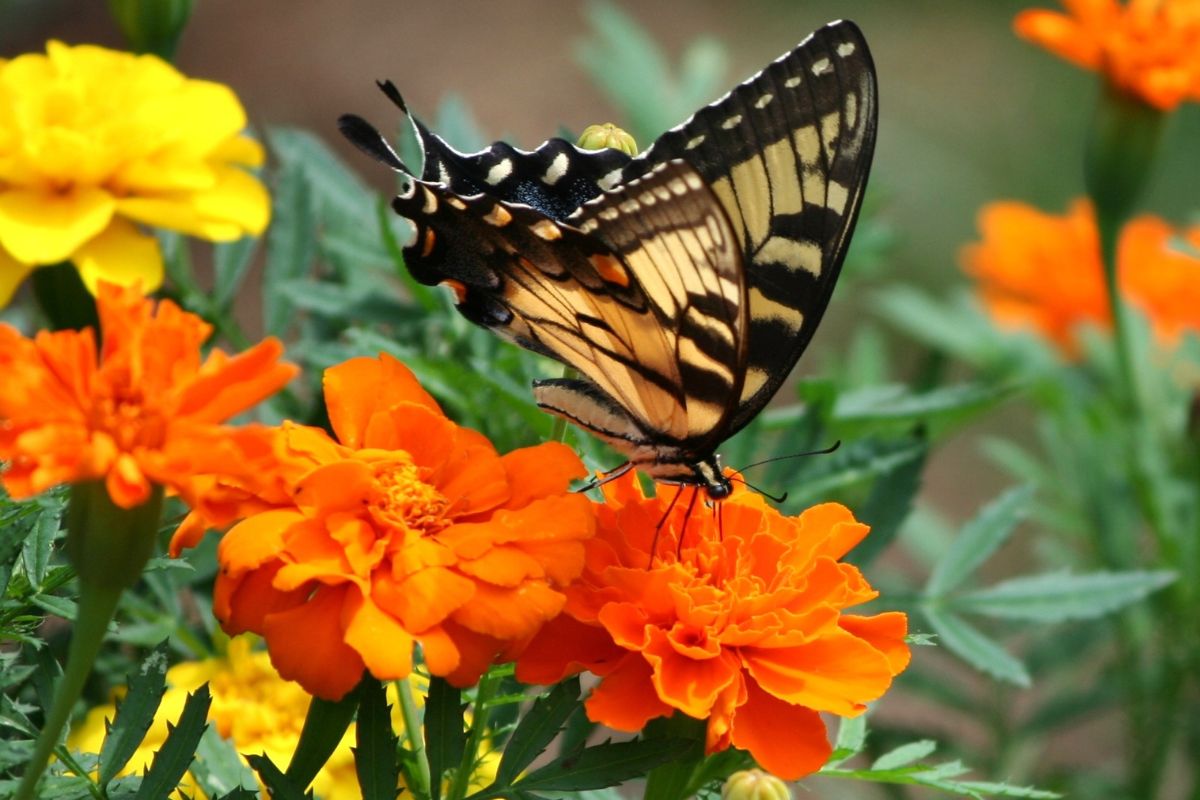
9. Californian Poppy
If you’re looking for a flower that’s not only good for beginner gardeners but also capable of thriving in poor soil conditions, look no further than the Californian poppy. Attractive, hardy, and easy to grow, these flowers are also drought tolerant. As a bonus, these flowers are edible and often used as a garnish or to make tea.
Growing these flowers is a breeze. While the seeds are a bit small, they’re not so small that they’re likely to blow away. You don’t need to soak or stratify them before planting, and you can sow them in several ways: individually in your garden, individually in small trays, or via the “scatter” method outdoors.
Californian poppies come in several attractive cultivars, including ‘Apricot Chiffon’, ‘Red Chief’, and ‘Purple Gleam’ among others. Just note that different poppy cultivars reach different heights – some remain less than 20 cm high, while others grow twice as tall.
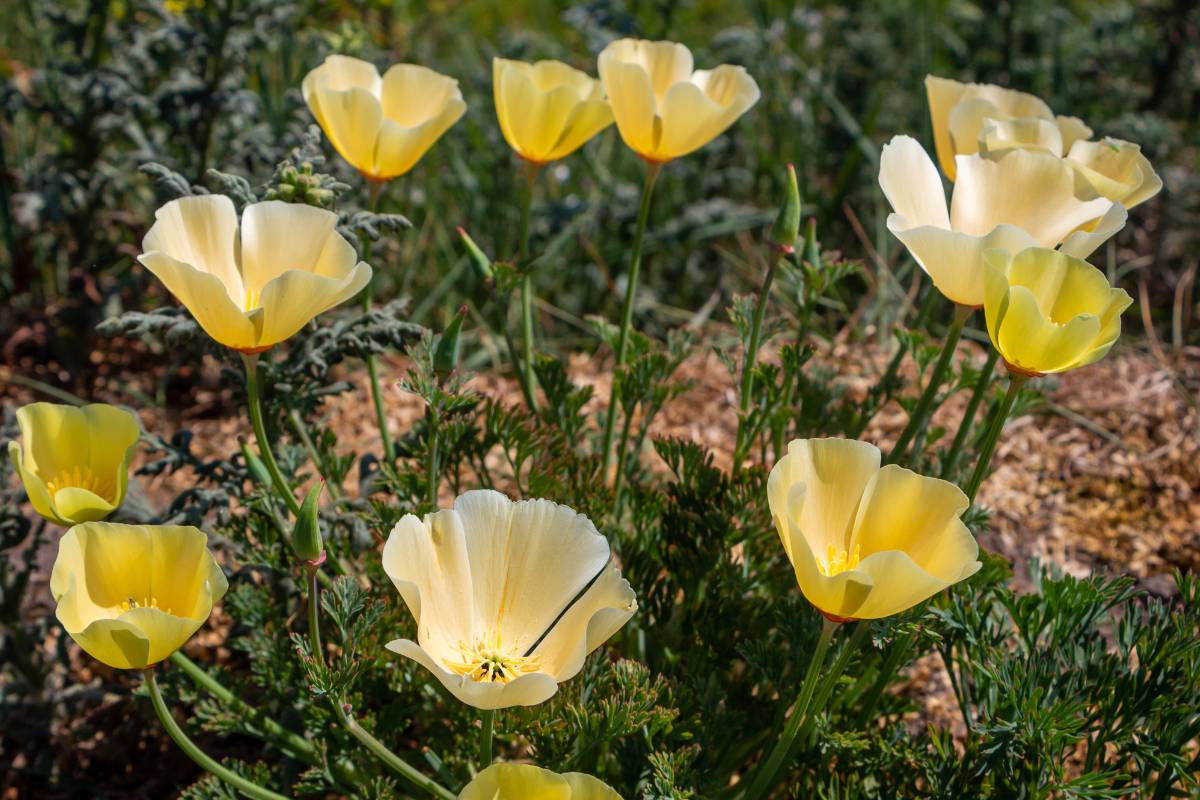
General Flower-Growing Tips for Beginners
Selecting easy-to-grow flowers is certainly important for fledgling gardeners, but there are a few other things you’ll want to bear in mind when you embark upon this new hobby. Among other things, you’ll want to:
- Acquire good quality tools. You don’t have to break the bank buying all the fanciest garden tools, but you will need a few key items to get started. This includes things like high-quality garden shears, a good soil moisture meter (also called a tensiometer), and some gardening gloves.
- Test your soil before selecting flowers. While most of the flowers discussed above will grow in a variety of soil conditions, it is always important to know your soil well. This will not only help you avoid selecting flowers that won’t thrive in your garden, but it can also be helpful when trying to troubleshoot problems.
- Familiarise yourself with the sun’s path over your yard, garden, or porch. You’ll need to select planting locations that provide the proper amount of sun exposure for the flowers you select. For example, many sun-loving flowers require six hours or more of direct sun, while those that can grow in partial shade may only require three hours of sun exposure per day. In either case, you’ll need to know the path the sun traces across your property so you can determine the ideal spot for different types of flowers.
- Learn about some of the most common seed-sowing mistakes. There are a variety of things beginners often do that prevent their plants from growing properly or the seeds from germinating at all. This includes everything from sowing seeds when the soil is the incorrect temperature, to sowing seeds too deeply, or using contaminated growing containers.
***
Growing flowers from seed can be really fun – especially if you’ve never grown anything before. Just be sure that you start with high-quality flower seeds, and purchase all of the necessary tools and supplies at the outset. This will give you the best chance of success, which will increase the chances of you sticking with your new hobby.




